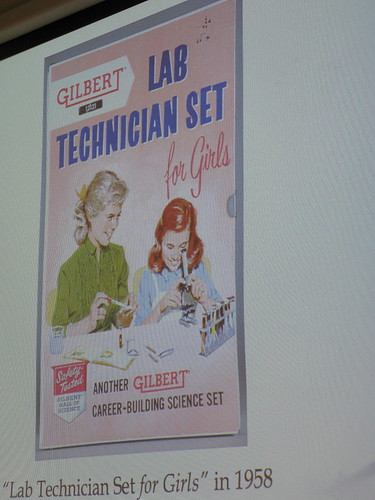In case anyone thinks the pink construction set (with sparkles) is a new thing: a chemistry set for girls, 1958 (USA). Or rather, a kit for a wannabe "Lab Technician", because the girl would be just supporting the actual chemist, naturally. Apparently it included a pink microscope. Mother and daughter look terribly happy though, don't they?
Apologies for bad quality photograph, it's of a powerpoint slide. From an event on 20th century popular science I ran yesterday (full blogpost on this forthcoming). The paper was given by Maggie Jack, a History and Philosophy of Science MPhil student at the University of Cambridge, based on the dissertation she wrote as an undergrad at Harvard.
Early/ mid 20th century chemistry sets were marketed quite explicitly for boys and their fathers, as if chemical experimentation was an opportunity for male bonding and general expression of red-blooded manhood. Fear not the explosions, take power over nature, etc, etc. Insert your favourite feminist philosopher of science here. It really wasn't anything subtle: the box covers and advertising for chemistry sets seemed to want to signal BOY, and do so as unequivocally as possible. This isn't just an American trend, Salim Al-Gailani (another HPS Cambridge student) gave a similar paper about UK chemistry sets at the 2007 British Society for the History of Science. It'd be interesting to know if the same was true in non-English speaking countries too.
I'm sure 1950s girls played with the non-pink chemistry sets, however they happened to be presented. Just as girls read Harry Potter, even if his name is bigger than J(oanne)K Rowling. It probably goes without saying that when it comes down to their actual use, gender messages of kids media aren't nearly as simple. In fact, one of the key points Jack wanted to make about Chemistry sets was the way they provided materials for exploratory work; that they allowed play through unintended consequences of science (indeed, they celebrated this), rather than necessarily being a matter of leading kids through a set of pre-ordained educational outcomes. I'm a bit too cynical to necessarily agree with her entirely on this, but it was a worthwhile point. Plus, my expertise on the topic is rather skewed to late 20th/ early 21st century kits: maybe such toys were a lot more exploratory in the past (even if gender identities were not?).
Finally, before we dismiss the pink microscope/ lab technician kit as a funny old 1950s thing, here's an fword post about chemistry kits, written just last year, which brings out some of the gender issues involved in our recent fashion for retro kids' non-fiction (*cough* Dangerous Book for Boys *cough*).
EDIT (15:10): from tip-off via twitter, a pink telescope with a lower power than the boy's model (worth scrolling through the comments on that post).
EDIT (15:25, 2nd April): from various comments I'm getting about this, I just want to underline that I can see how a pink microscope might be seen as something quite empowering, a positive expression of feminine science (now as much as in 1958). Personally, I'm not convinced by this argument, but I don't think we should simply say pink stinks and that's the end of the debate. Gender issues are always complex, in toys and in science perhaps no less so.
Subscribe to:
Post Comments (Atom)


I have a brother who is seven years older than me. I remember when I was five I took over his (metal) Tonka trucks and when I was 12 I took over his chemistry set and microscope. I loved those science tools and am grateful I had an older brother because many of the things I played with as a child or did as a teen would not otherwise have been made available to me, in any color. (I was born in 1957.)
ReplyDeleteCurrent chemistry kits seem too tame to provide any fun or true exploration these days.
That's a great story - thanks! I'm sure there were loads of people who had access to kits like that for similar reasons. Oddly I think my little brother ended up with a load of science books and toy trucks he didn't bother with :) (I was born in 1981).
ReplyDeleteAs for tame-ness: one of the really interesting things we discussed at the conference was the way in which a chemistry set might be seen as a "taming" of such play in itself. In the 1950s, the really cool kids ordered chemicals direct from suppliers, or just bought them from a chap down the road. (apparently, my Dad turned his school swimming pool purple with some stuff they just nicked out the back of the school lab).
A service targeted for schools to enable cloud based management system and communication between the school and parents.We, at schoollog, also provide mobile application for parent teacher communication. Parents can see students attendance, their marks, homework given to students, fees that is pending and that has been paid, and notifications sent by school. For further details, please visit - https://schoollog.in/ Schoollog
ReplyDelete